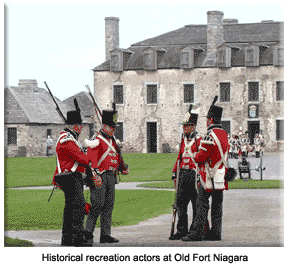The area between lakes Erie and Ontario, traversed by the Niagara River, was recognized by the earliest European explorers as a region of potential strategic importance. La Salle in the 1670s constructed a small outpost there, Fort Conti, which housed a stockade and a fur warehouse. Poor relations with the neighboring Iroquois and the remoteness of the location made it difficult for the French to maintain a consistent presence there in the ensuing years.
 A more permanent structure was erected by later French interests in 1726. On this occasion, they took the precaution of gaining Iroquois permission before occupying a spot on a bluff above the river. The fort underwent several name changes, but eventually came to be known as Fort Niagara.
The fort played no role in King George’s War (1740-48), the third of four Anglo-French wars for control of North America. However, the final conflict — the French and Indian War — saw much action at this location. In 1755, French troop strength at Fort Niagara was sharply increased and a major effort was made to expand its facilities. The British selected the stronghold as a prime target in the opening stages of the conflict, but Braddock’s stunning defeat abruptly ended thoughts of an attack.
However, the success of Jeffrey Amherst’s grand British offensive of 1759 would hinge upon capturing the fort, which was the key French position in the West. To prepare for this task, the British successfully enlisted the Iroquois, who provided decisive aid by turning back desperately needed French reinforcements. After a 19-day siege, the French commander at Fort Niagara received word that his forces would not be rescued; he sought and received terms of surrender from William Johnson in July.
With the Fort Niagara distraction removed, the British armies were freed to concentrate their attentions on French positions on Lake Champlain and the St. Lawrence River.
A more permanent structure was erected by later French interests in 1726. On this occasion, they took the precaution of gaining Iroquois permission before occupying a spot on a bluff above the river. The fort underwent several name changes, but eventually came to be known as Fort Niagara.
The fort played no role in King George’s War (1740-48), the third of four Anglo-French wars for control of North America. However, the final conflict — the French and Indian War — saw much action at this location. In 1755, French troop strength at Fort Niagara was sharply increased and a major effort was made to expand its facilities. The British selected the stronghold as a prime target in the opening stages of the conflict, but Braddock’s stunning defeat abruptly ended thoughts of an attack.
However, the success of Jeffrey Amherst’s grand British offensive of 1759 would hinge upon capturing the fort, which was the key French position in the West. To prepare for this task, the British successfully enlisted the Iroquois, who provided decisive aid by turning back desperately needed French reinforcements. After a 19-day siege, the French commander at Fort Niagara received word that his forces would not be rescued; he sought and received terms of surrender from William Johnson in July.
With the Fort Niagara distraction removed, the British armies were freed to concentrate their attentions on French positions on Lake Champlain and the St. Lawrence River.